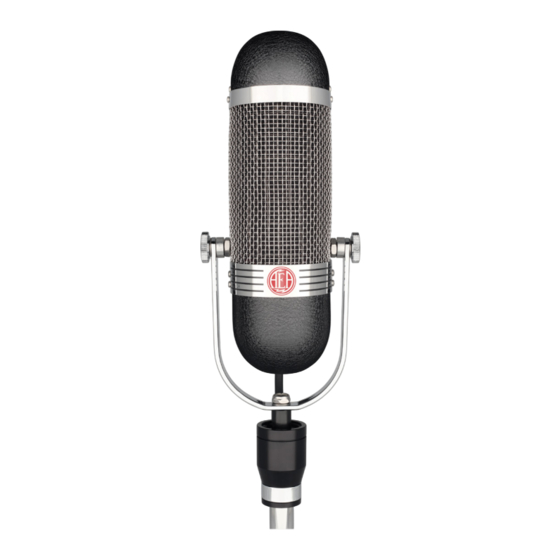
AEA R84 series Owner's Manual
Hide thumbs
Also See for R84 series:
- Owner's manual (16 pages) ,
- User manual (8 pages) ,
- Owner's manual (12 pages)
Table of Contents
Advertisement
Quick Links
Advertisement
Table of Contents

Summary of Contents for AEA R84 series
- Page 1 AEA R84 SE RIES OWNER’S MANUAL CLASSIC RIBBON MIC INSPIRED BY THE R44...
-
Page 2: Welcome
WELCOME Congratulations on your purchase of an AEA R84 series microphone. R84 series mics are flexible and practical in a myriad of recording settings. Developed to have a classic sound from the same family as the R44, R84 series microphones deliver exceptional headroom while maintaining an intimate performance quality with smooth highs and extended lows. - Page 3 CONTENTS WELCOME INTRODUCTION SUPPORT GENERAL GUIDELINES APPLICATION ADVICE SPECIFICATIONS...
-
Page 4: Introduction
Register your microphone at AEAribbonmics.com SUPPORT If you should encounter any problems with your microphone or have questions regarding using your R84 series mic in specific application, please contact our customer support team at support@ ribbonmics.com. To talk to a live human being, call +1 (800) 798-9127, between 9:00 A.M.- 5:00 P.M. -
Page 5: General Guidelines
R84A Phantom-Powered Microphone The phantom current draw for active AEA ribbon mics is 7 milliamps. IEC specifies P48 power which should be able to deliver 10 milliamps per input. Some USB and battery-powered audio interfaces will not deliver this. - Page 6 Minute iron particles, sometimes known as “tramp iron,” are common within our environment. AEA ribbon microphones contain powerful magnets that produce strong magnetic fields. These fields can attract any ferric metal near the microphone that, if they are small enough, can penetrate the outer screening and work their way inside the microphone.
- Page 7 The high-performance magnets used in AEA microphones are incredibly strong, and a significant amount of stray magnetic field lines surround the microphone. Avoid placing the microphone in close proximity to hard drives, credit cards, analog tape, or any other magnetically sensitive items to prevent any data loss.
-
Page 8: Application Advice
We actively encourage users to visit AEAribbonmics.com access our comprehensive collection of in-depth articles and tutorials featuring the R84 series microphone, along with a library of audio and video demonstrations of the R84 series in action. A FIGURE-OF-8 MICROPHONE Figure-of-8 microphones... - Page 9 other, they introduce their own set of problems - not the least of which are reflections in close proximity to the performers and/ or microphones that result in comb-filter distortions. Since gobos usually are bulky, they also inhibit the ability of the musicians to hear and see each other easily.
-
Page 10: Frequency Response
The R44’s proximity effect begins at six feet (1.8 M) and can become huge. The RCA 44 was developed when studios were larger and mics were rarely used close up. Compared to the R44, the R84 has a more moderate proximity effect. Designed to accommodate both distant and medium miking duties, it exhibits a flat frequency response when placed 3 feet (1 meter) away from the source. -
Page 11: Specifications
SPECIFICATIONS Operating Principle: Pressure gradient transducer Directional Pattern: Bidirectional Frequency Range: <20 Hz to >20 kHz Polarity: Pin 2 high for positive pressure on front of microphone Polar Response: Native bidirectional, figure-of-8 pattern Horizontal: Up to 90 dB rejection at right angles to the front/back axis. - Page 12 AEARIBBONMICS.COM | @RIBBONMICS | INFO@RIBBONMICS.COM | (800) 798-9127...
















Need help?
Do you have a question about the R84 series and is the answer not in the manual?
Questions and answers